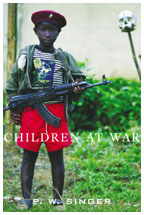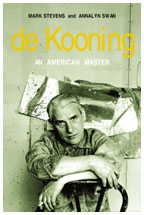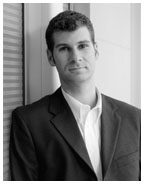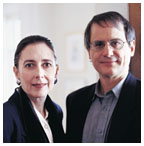January 26, 2005: Reading Room
Children are regularly forced to fight in conflicts around the world, writes P.W. Singer ’97. (Dennis Drenner) |
Kids
who kill
P.W. Singer ’97 explores a growing trend: using children
as soldiers
By Maurice Timothy Reidy ’97
As a senior in the Woodrow Wilson School, P.W. Singer ’97 wrote part of his thesis on what, at the time, was a relatively new development in contemporary warfare: hiring out private contractors to perform work usually reserved for soldiers. Later he turned his thesis into a book, Corporate Warriors: The Rise of the Privatized Military Industry (2004), which drew international media attention to a practice that is now regularly employed in Iraq. In 1998 Singer landed a job with the Balkans Task Force in the Office of the Secretary of Defense, where he helped organize the international team that documented human rights abuses in Kosovo.
Now, in Children at War, published by Pantheon this month, Singer explores another development that has become a tragic part of wars around the globe, from Colombia and the Sudan to Kashmir and Iraq: using children as soldiers. The first American killed in Afghanistan was shot by a 14-year-old boy. And the insurgents in Iraq regularly use children as decoys or soldiers.
“Every single place U.S. forces have been deployed in the war against terror — those are child-soldier zones,” says Singer, now a fellow at the Brookings Institution in Washington, D.C.
 According
to U.N. estimates, there are more than 300,000 children fighting in conflicts
around the world. That’s 10 per- cent of all combatants, up from
nearly zero a few decades ago, Singer says. He defines children as those
under the age of 18, a standard accepted by international law. But in
places like Uganda, there are children as young as eight who fight.
According
to U.N. estimates, there are more than 300,000 children fighting in conflicts
around the world. That’s 10 per- cent of all combatants, up from
nearly zero a few decades ago, Singer says. He defines children as those
under the age of 18, a standard accepted by international law. But in
places like Uganda, there are children as young as eight who fight.
For centuries, one of the unwritten rules of war was that children would never be used in battle, says Singer. But that has changed with the advent of smaller and lighter weapons, which make fighting easier, and the prevalence of diseases like AIDS, which, among other things, has created a substantial number of orphans, “a group especially susceptible to being pulled into war,” writes Singer. Today, children are regularly abducted and forced to fight by rebels and military leaders in hot spots around the world. In Sierra Leone, for example, children played a prominent role in the 10-year civil war. And in Uganda, rebel leader Joseph Kony has used children to wage a long and bloody battle against the government.
When Singer first began studying this phenomenon, some people were skeptical that the practice was as widespread as he contends. One participant at a scholarly conference bluntly told him: “I don’t believe you.” But policy-makers “can’t pretend [child soldiers] don’t exist,” Singer says.
Singer lays out several ways world leaders can reduce the number of
child soldiers, including defining the practice as a war crime and increasing
funding for programs designed to integrate child soldiers back into society.
Children are severely scarred by fighting and are often among the first
to fight when war begins again, says Singer. “Former child soldiers,”
Singer writes, “must be treated like the victims they are.”
![]()
Maurice Timothy Reidy ’97 is an associate editor at Commonweal Magazine.
Annalyn Swan ’73 and Mark Stevens ’73 interviewed hundreds of contemporaries in de Kooning’s artistic and social circles. (Knopf) |
Studying
the master
Mark Stevens ’73
and Annalyn Swan ’73 plumb artist Willem de Kooning
By Louis Jacobson ’92
Mark Stevens ’73 interviewed Willem de Kooning only once, in the late 1970s, when the celebrated painter was nearing the end of his career and suffering from the early stages of dementia. “He was about 5-foot-7 and grizzled, but there was a brightness in his eye and a wry expression on his face,” Stevens recalls. “He had two rocking chairs in a very large studio. He’d sit in one and you’d sit beside him, both rocking. He always had one eye on his paintings, even as you were talking about other things.”
About a decade after that meeting, Stevens and his wife, Annalyn Swan ’73, began research on a biography of de Kooning. After another decade, their 700-page book, De Kooning: An American Master, was published by Knopf in November.
Stevens and Swan, seasoned art critics, suspected that de Kooning, who grew up poor in the Netherlands and emigrated to the U.S., would be a worthy subject for a full-length biography. “Immigration is one of the great American themes, and in de Kooning, the story plays out in a classical way,” says Stevens, a Woodrow Wilson School major at Princeton who has been an art critic at Newsweek, The New Republic, and now New York magazine. Moreover, in a century notable for increasing mechanization and technical innovation in art, de Kooning was one of the last painters who lived and died by “the bravura brushstroke,” says Swan, an English major who has been a music critic and senior arts editor for Newsweek.
 A key
member of the surrealist and abstract-expressionist movements in the 1940s
and 1950s, de Kooning and his reputation faded in the 1960s, but he returned
to prominence in the 1970s with works that blended human figures into
landscapes, continuing into the 1980s with more abstract “ribbon”
paintings. After suffering from dementia for almost two decades, de Kooning
died in 1997 at age 93.
A key
member of the surrealist and abstract-expressionist movements in the 1940s
and 1950s, de Kooning and his reputation faded in the 1960s, but he returned
to prominence in the 1970s with works that blended human figures into
landscapes, continuing into the 1980s with more abstract “ribbon”
paintings. After suffering from dementia for almost two decades, de Kooning
died in 1997 at age 93.
Stevens and Swan, who first met at the Daily Princetonian, interviewed hundreds of contemporaries in de Kooning’s artistic and social circles. The artist’s daughter, Lisa de Kooning, along with her mother, Joan Ward, proved extremely helpful. (Ward and de Kooning had an affair in the 1950s and remained close until his death.) Lisa de Kooning and Ward didn’t flinch when the authors probed the artist’s personal side, including his many extramarital affairs, his alcohol abuse, and his sometimes-stormy relationships with friends, Stevens says.
As they delved into de Kooning’s story, Stevens and Swan discovered an artist with a sense of humor — something of a rarity among midcentury art-world giants. “He hated pretense and loathed highfalutin language about art,” Swan says. Even the grotesque, rage-filled approach to the female form seen in de Kooning’s “Woman” paintings struck Stevens and Swan not as simple misogyny, as some critics have long believed, but as having a palpable undercurrent of humor.
Now that they’ve spent a decade of their lives researching one
man, Stevens and Swan say they have no regrets about their choice. “We
saw him warts and all,” Swan says, “but still, we can tremendously
admire what he stood for, and what he added to 20th-century art.”
![]()
Louis Jacobson ’92 is deputy editor of Roll Call, a newspaper covering Capitol Hill.
BOOK SHORTS
 Greece: Images
of an Enchanted Land — Robert A. McCabe ’56 (Patakis).
In this coffee-table book of black-and-white photographs taken in Greece
from 1954 to 1965, McCabe captures an era before tourism took over. The
photographs depict the unspoiled landscape, the waterfronts, important
sites such as the temple of Apollo, and people carrying out daily routines
— women doing laundry at a river and boys tending sheep. McCabe
is chairman of the New York-based Pilot Capital Corporation.
Greece: Images
of an Enchanted Land — Robert A. McCabe ’56 (Patakis).
In this coffee-table book of black-and-white photographs taken in Greece
from 1954 to 1965, McCabe captures an era before tourism took over. The
photographs depict the unspoiled landscape, the waterfronts, important
sites such as the temple of Apollo, and people carrying out daily routines
— women doing laundry at a river and boys tending sheep. McCabe
is chairman of the New York-based Pilot Capital Corporation.
 Make the
Rules or Your Rivals Will — G. Richard Shell ’71
(Crown Business). The author argues that successful businesses must learn
to use legal tools — strategic contracts, litigation, regulation,
and lobbying — to secure competitive advantage. Drawing on contemporary
case studies as well as business history, he explores how laws shape markets
and how corporate leaders from Henry Ford to Bill Gates have used (and
sometimes abused) legal strategies. Shell is the Thomas Gerrity Professor
at the Wharton School at the University of Pennsylvania.
Make the
Rules or Your Rivals Will — G. Richard Shell ’71
(Crown Business). The author argues that successful businesses must learn
to use legal tools — strategic contracts, litigation, regulation,
and lobbying — to secure competitive advantage. Drawing on contemporary
case studies as well as business history, he explores how laws shape markets
and how corporate leaders from Henry Ford to Bill Gates have used (and
sometimes abused) legal strategies. Shell is the Thomas Gerrity Professor
at the Wharton School at the University of Pennsylvania.
 John
the Painter: Terrorist of the American Revolution — Jessica
Warner ’78 (Thunder’s Mouth). The author blends social history
and psychology in tracing the life of a little-known revolutionary, James
Aitken. Known as John the Painter, he was born in Scotland, immigrated
to America as an indentured servant, served as a British soldier, deserted,
and eventually plotted to take down the Crown. Warner is an assistant
professor in the psychiatry department at the University of Toronto.
John
the Painter: Terrorist of the American Revolution — Jessica
Warner ’78 (Thunder’s Mouth). The author blends social history
and psychology in tracing the life of a little-known revolutionary, James
Aitken. Known as John the Painter, he was born in Scotland, immigrated
to America as an indentured servant, served as a British soldier, deserted,
and eventually plotted to take down the Crown. Warner is an assistant
professor in the psychiatry department at the University of Toronto.
 Universal
Jurisdiction: National Courts and the Prosecution of Serious Crimes Under
International Law — edited by Stephen Macedo *87 (University
of Pennsylvania). A collection of essays by leading scholars, this book
discusses the origins, evolution and implications of “universal
jurisdiction” — the principle that any state is entitled to
prosecute heinous crimes such as genocide in its national courts, no matter
where the crimes were committed. Macedo, a professor of politics at Princeton
and director of the University Center for Human Values, also chaired the
Princeton Project on Universal Jurisdiction, from which this book originated.
Universal
Jurisdiction: National Courts and the Prosecution of Serious Crimes Under
International Law — edited by Stephen Macedo *87 (University
of Pennsylvania). A collection of essays by leading scholars, this book
discusses the origins, evolution and implications of “universal
jurisdiction” — the principle that any state is entitled to
prosecute heinous crimes such as genocide in its national courts, no matter
where the crimes were committed. Macedo, a professor of politics at Princeton
and director of the University Center for Human Values, also chaired the
Princeton Project on Universal Jurisdiction, from which this book originated.
 Private
Lives in Renaissance Venice — Patricia Fortini Brown (Yale).
Through artwork, photographs, illustrations, and text, the author re-creates
what life was like inside the walls of a 16th-century noble household
in Venice. Brown describes how palaces were furnished and decorated, how
guests were entertained, what people wore, and how children were raised,
among other aspects of aristocratic life. Brown is professor and chairwoman
of the department of art and archaeology at Princeton.
Private
Lives in Renaissance Venice — Patricia Fortini Brown (Yale).
Through artwork, photographs, illustrations, and text, the author re-creates
what life was like inside the walls of a 16th-century noble household
in Venice. Brown describes how palaces were furnished and decorated, how
guests were entertained, what people wore, and how children were raised,
among other aspects of aristocratic life. Brown is professor and chairwoman
of the department of art and archaeology at Princeton. ![]()
By K.F.G.
More books by alumni and faculty are listed on the web, click here.
For a complete list of books received, click here.


